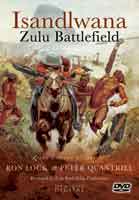Isandlwana. For me it conjures up images of carnage, panic and total and absolute fear.As a child I remember watching the film Zulu with my father. This was back in the day when we only had four channels on British TV and Zulu was only on once a year. I was very aware of the heroic stand by Queen Victoria’s soldiers at Rorke’sDrift and the surrounding pomp and circumstance of this action thatthe film portrayed. Then, when I was about nine years oldand after saving my pocket money I went to my local toyshop and bought a large box of soldiers, men of the 24th foot and Zulu warriors to be exact. It wasn’t the actual toys that fascinated me as such; it was the box. The cover was an image that I would stare at for hours on end. I remember removing the box out from under my bed and staring at the picture in the middle of the night until I was wide eyed, horrified and scared witless. The image I stared at for so many years was C E Fripp’s The Battle of Isandlwana. Never in my eyes has a painting come near to such an atmospheric and frighteningrendition of war. It remains my favourite painting to this day.
What of Isandlwana the battle though? Well, the background to the Zulu War itself is as complex and as deep as you want it to be. In short terms, however, in 1878 The British Empire was stretching it’s might in South Africa and had pushed as far as Zululand, or what is today KwaZulu-Natal, give or take a few minor border changes. It was knocking at the door of the great Zulu kingdom, and it was knocking hard. The problem for the British, though, was the owners weren’t in the mood for answering anymore.Early in 1879, after repeated requests from the Zulu king Cetshwayo, to basically go away, the British somewhat unwittingly backed the Zulus into a corner in their own home and Cetshwayo’swarriors came out fighting in such a way as to reel and shake the British Empire to it’s very roots and leave it licking its wounds for many years to come.
It sounds basic, but then sometimes that’s what things are.We have an urge to ‘overcook’ things at times and look for different meanings that aren’t always there.Well, not this Documentary. At an hour long it starts at the right tempo and leaves you hanging on for more at the end. It’s a gateway to another slice of military history; a teaser into a bigger historical landmark that is so well presented and explained with just enough of the right detail that you’re sure to be looking for further material to read or view. In my eyes this is exactly what a documentary should do.
It explains the make up of a Zulu army or impi, the weapons so feared by the whites and the ritual and medicinal ceremonies of the Zulus. Let’s not forget, prior to the British defeat at Isandlwanathe Empire hadn’t fought these brave warriors before. When, on the morning of January 22nd twenty thousand Zulu warriors cascaded up to the landmark rock that is Isandlwana and poured into the tented camp of some estimated eighteen hundred British and Colonial troops and began their destruction piecemeal they left some thirteen hundred British dead. That’s more than the British casualty figures for D-Day! The documentary shows period photographs and paintings and re-enactments of the day.It also cleverly uses black and white film footage from past films to cast your mind even further into the maelstrom and to give you an idea of just what a Zulu impi would have looked like on the move. It’s to the point and explains the various heroic (and some not so heroic) incidents and gives a damn goodtaste of the terrain and geographical nightmare faced by both sides.
If, like me, you already know a good deal about the Zulu War this film still goes a long way to enlighten you further on the subject. If you’re new to the period and want to know more then there really is no excuse for you not to view this documentary. I guarantee this will only feed and stoke the fire (and we all know we shouldn’t present the Zulus with the gift of fire!) and it will spark your passion and deepen your mind for the whole Zulu experience It’s one of the most blood thirsty and heroic accounts of a battle anywhere and one that will amaze and astonish you.
Just remember, make sure you have a copy of C E Fripp’s painting of Isandlwana to hand. You may just well end up staring at it in wide-eyed wonder like I did all those years ago.Just don’t let it keep you up at night and if it does..bolt the door,put the chain on and don’t answer the knocking !
Usuthu !!!!
Reviewed by Phil Hodges for War History Online.
ISANDLWANA
Zulu Battlefield
By Ron Lock and Peter Quantrill
From Pen&Sword
ISBN 024762106-4
